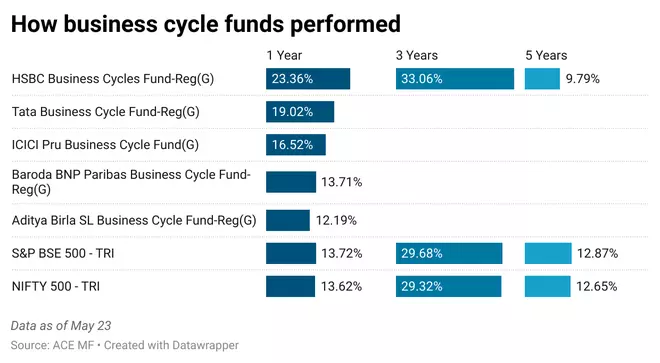Rapid growth, a slump or recession, and recovery are some of the economic phases that any country goes through. Consequently, and due to a few other additional factors, businesses go through their own ebbs and flows.
Macroeconomic factors, global economic growth, technological disruptions, and demographics influence the fortunes of industries. At the micro level, these factors, along with interest rates, inflation, capex cycles, government policies, and so on, tend to create business cycles.
Joining the list of many other fund houses, Quant has rolled out a business cycle fund. The new fund offer (NFO) will close on May 25.
Read on for more on the NFO before you make an investment call.
How the fund is positioned
There is always a churn in different sectors based on market and business cycles. For example, in the immediate aftermath of the Covid-19 pandemic, information technology and pharma sectors were in great demand, especially as valuations, too, were attractive. Later on, banks, public sector companies and automobiles rallied and have continued to remain in favour, given that they came from depressed valuations. Meanwhile, over the past year or so, IT and pharma sectors have gone out of favour due to slowdown in the US and most other developed markets as interest rates were increased sharply to counter inflation.
Also read
Also read:Quant Dynamic Asset Allocation Fund NFO: Should you invest?
With the Indian government committed to massive infrastructure spends, the domestic capex cycle may throw up winners in the capital goods, power and other key sectors.
Quant Business Cycle will use a predictive analytics model to identify the right sectors and the allocation levels. The fund will look to concentrate on 3-4 sectors from among a list of 6-8 segments. Maximum exposure to any sector will be capped at 33.33 per cent. It will rely on macroeconomic analysis to identify sectors that are on the verge of an upcycle.
The fund will take a multi-cap approach to investing in different sectors. Quant has a VLRT (valuation analytics, liquidity analytics, risk appetite analytics and timing) framework. The fund house is known to churn its portfolio in the quest for better returns. In most categories, the fund has its schemes among the top few in terms of performance in the last 3-4 years.

What investors must do
Business cycle funds have been around only for the past couple of years — barring HSBC Business Cycles fund (via L&T Mutual Fund’s acquisition), which has a five-year track record). While HSBC Business Cycles has done well over the past three years, it has underperformed the Nifty 500 TRI over the past five-year period. Given the limited track record of funds with the business cycle theme, it may be too early to judge their performance.
Investors with an appetite for risk and confident about the India growth story can consider thematic funds based in infrastructure or banking and financial services, as these have an established track record, and some have delivered healthy returns over the long term.
Also read:Hit by global headwinds, most equity new fund offers of MFs post negative returns in last one year
Besides, sectors on the verge of a cyclical uptick are also sought by diversified equity schemes of all hues, though, of course, sector and stock exposures are concentrated in the case of business cycle funds.
Investors can wait for the new fund to develop a performance record before taking exposure.










Comments
Comments have to be in English, and in full sentences. They cannot be abusive or personal. Please abide by our community guidelines for posting your comments.
We have migrated to a new commenting platform. If you are already a registered user of TheHindu Businessline and logged in, you may continue to engage with our articles. If you do not have an account please register and login to post comments. Users can access their older comments by logging into their accounts on Vuukle.